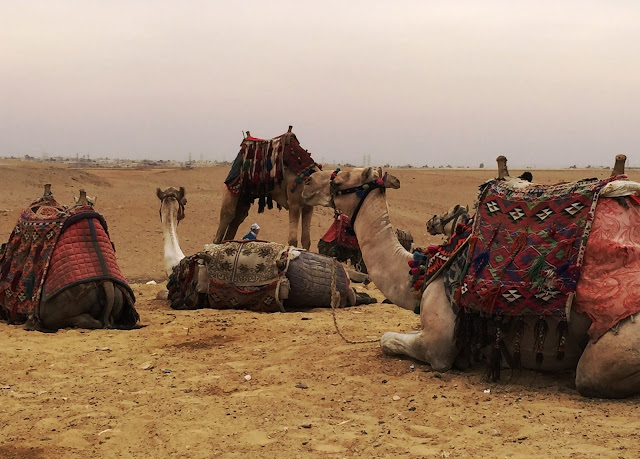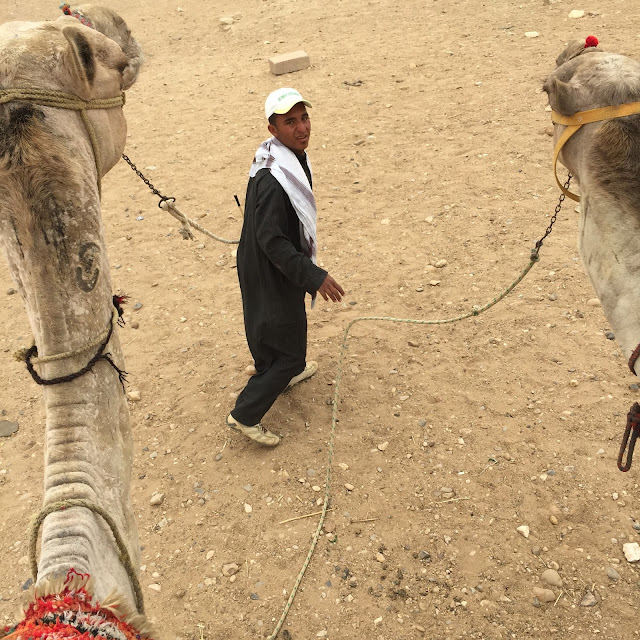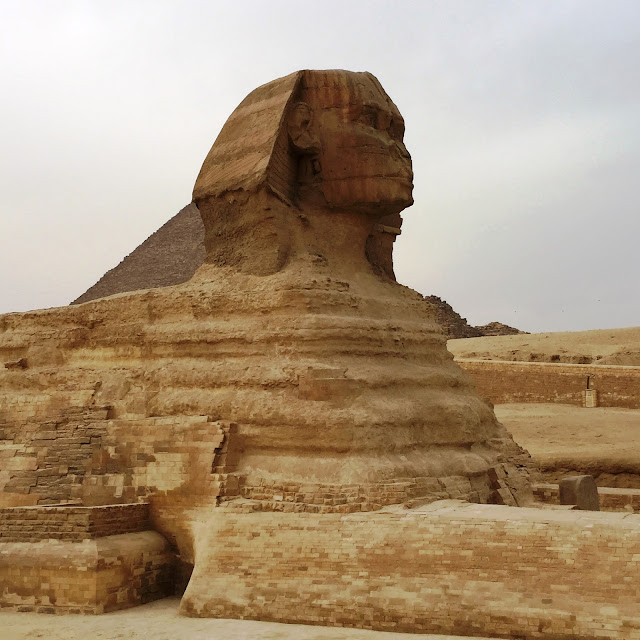"At the distance of a few miles the Pyramids rising above the palms looked very clean-cut, very grand and imposing, and very soft and filmy, as well. They swam in a rich haze that took from them all suggestions of unfeeling stone, and made them seem only the airy nothings of a dream--structures which might blossom into tiers of vague arches, or ornate colonnades, maybe, and change and change again, into all graceful forms of architecture, while we looked, and then melt deliciously away and blend with the tremulous atmosphere."
Yes, yes, we could see exactly what he was talking about as we approached them, especially that part about the "tremulous atmosphere." (Is that a euphemism for "smog"?)
We had seen them a few times from a distance as we were driving around the city and were suprised by how they stand out. Cairo covers a lot of area, and the edges of the city creep right up to the pyramids. Rising 481 feet above the desert, the largest of the pyramids, the Great Pyramid of Giza, was the tallest man-made structure in the world for over 3,700 years. (Note: It was replaced by the Lincoln Cathedral in England, built in 1092, which stood at 525 feet. These days the tallest building in the United Arab Emirates, the Khalifa Tower, is over 2,700 feet tall.)
 |
| Picture from Wikipedia |
Of course, I recognized them right away. They are pretty good copies of the pyramids and sphinx in the town where I live in Southern California:
 |
| Photo from here |
There are six pyramids at Giza (I'm not sure where the other two are hiding), and altogether they are known as the Giza Necropolis, or City of the Dead:
Bruce Feiler, author of Walking the Bible, states:
"The pyramids are the only surviving object of the Seven Wonders of the Ancient World and would probably still make a list of the seven most wondrous objects in the world. Stop a hundred people anywhere on the planet and ask them where the pyramids are and it's hard to imagine a score below 100. The oldest and largest of the pyramids, built . . . around 2650 B.C.E., is 480 feet high and covers an area of 13.6 acres, equivalent to seven square blocks in midtown Manhattan, or twice the size of Times Square. The building uses 2,300,000 limestone blocks, each one about the size of a large refrigerator-freezer and weighing an average of three tons, with a few reaching fifteen tons. Lined end to end these stones would pave a single-lane road from San Francisco to New York."
Okay, twice the size of Times Square? That is colossal. And 4,665 years old? That accounts for its stony wrinkles:
This pyramid used to have a smooth outer covering (just like most of us and also like the crown at its peak), but that has eroded away to reveal the skeletal framework underneath. Twain pointed out:
"A laborious walk in the flaming sun brought us to the foot of the great Pyramid of Cheops. It was a fairy vision no longer. It was a corrugated, unsightly mountain of stone. Each of its monstrous sides was a wide stairway which rose upward, step above step, narrowing as it went, till it tapered to a point far aloft in the air. Insect men and women . . . were creeping about its dizzy perches."
Tourists used to be able to ascend the dizzying heights, but no longer. Darn.
It is mind-boggling to think about how long the pyramids have been around, and how relatively unchanged they are. If it weren't for all that stuff in the background and the paved road, we could have almost believed we had stepped back in time 150 years to join Mark Twain and the steady stream of American tourists that even then found these structures to be hauntingly irresistible:
Just as in Twain's day, the camel masters were eagerly awaiting our arrival, ready to assist us as we mounted one of their dignified steeds:
Ewww....
By the way, can you believe that these photos are not crammed full of tourists? Imagine what the tourism crash is doing to the economy.I suppose a few other hints that we weren't joining Twain's 1867 expedition are the baseball cap on the camel master and the heavy smog rolling off Cairo:
Such handsome fellas:
Off we go into the wild brown yonder!
Chris and Stan look like the well-born gentry that they are:This might be our Christmas card this year:
Or maybe this one with Chris the Photo-Bomber:
Somehow I didn't get a picture of Bob riding solo on his camel, but let me assure you that he was as dashing as Errol Flynn.
I kept thinking of my mom and her trip to Egypt for the International Reading Conference. It was 1983 or 1984, and she was 57 or 58 years old, just a few years older than I am now (closer to the age of my sister Chris). That's her on the left, riding a camel at the Pyramids of Giza.
Ever the adventurer, she would love that two of her daughters were following her lead and riding their own camels in Egypt. I tried to re-create her pose. I hope she was watching.
A little later Bob and I tried riding tandem:
"Oh, you'll look sweet / Upon the seat / Of a camel hump built for twoooooo!"

SO much fun!
We also had the grand opportunity to enter the Great Pyramid. Again, no photos were allowed, but that's okay because there really wasn't much to see. Anything of beauty or of value was taken by tomb robbers about 4,660 years ago. There are no hieroglyphic inscriptions on the walls. No fancy architecture. No gold.
 |
| Diagram from here |
We walked whatquite a distance up a long, narrow, claustrophobic corridor:
 |
| Photo from here |
At the end of the path was the King's Chamber, which appears to have been significantly redecorated since the time of Khufu/Cheops with an emphasis on concrete. And no, that's not a big bathtub in the center; it is the king's sarcophagus, lackluster in comparison to what we'd seen in the Valley of Kings and the Egyptian Museum:
 |
| Photo from here |
In spite of the less than inspiring ornamentation, it was a major charge to be inside the most ancient structure on Earth!!
We also spent some time with the Great Sphinx. Twain was uncharacteristically solemn as he described his encounter with it:
"After years of waiting, it was before me at last. The great face was so sad, so earnest, so longing, so patient. There was a dignity not of earth in its mien, and in its countenance a benignity such as never anything human wore. It was stone, but it seemed sentient. If ever image of stone thought, it was thinking. It was looking toward the verge of the landscape, yet looking at nothing--nothing but distance and vacancy. It was looking over and beyond every thing of the present, and far into the past. It was gazing out over the ocean of Time . . . . It was thinking of the wars of departed ages; of the empires it had seen created and destroyed; of the nations whose birth it had witnessed, whose progress it had watched, whose annihilation it had noted; of the joy and sorrow, the life and death, the grandeur and decay, of five thousand slow revolving years. . . . It was MEMORY--RETROSPECTION--wrought into visible, tangible form. All who know what pathos there is in memories of days that are accomplished and faces that have vanished--albeit only a trifling score of years gone by--will have some appreciation of the pathos that dwells in these grave eyes that look so steadfastly back upon the things they knew before History was born--before Tradition had being--things that were, and forms that moved . . . .
"The Sphynx is grand in its loneliness; it is imposing in its magnitude; it is impressive in the mystery that hangs over its story. And there is that in the overshadowing majesty of this eternal figure of stone, with its accusing memory of the deeds of all ages, which reveals to one something of what he shall feel when he shall stand at last in the awful presence of God." (Innocents Abroad)
Wow. NOT what I was thinking. To be honest, I was a little disappointed by the Sphinx. Had I overdosed on magnificence during our Egyptian Odyssey? Was I simply numb to what Twain seemed to see as the immeasurable power of this face? Well, I thought it would be closer to the pyramids and that it would be much bigger than it was--241 feet long, 63 feet wide, and over 60 feet high. If it sat on a football field, there would be ten yards of turf in front of it and ten yards behind it and about 16 yards on each side. Try envisioning that from your seat in the stands. How could I not think it was big? It also happens to be the largest monolith (a statue made from a single block of stone) in the world.
Or maybe I expected the HEAD, thought to be the face of the Pharaoh Khafra (Khufu's son), to be bigger or in better shape. Thought to have been built around 2500 BC, the Sphinx is just a century younger than the Great Pyramid of Khufu/Cheops, which accounts for that lumpy, less-than-toned body:
I did love the tail. I don't think I realized the Sphinx would have a tail:
My husband's side of the family has its own history in Giza. My husband's grandfather, Edwin Q. Cannon, served an LDS mission in Switzerland and Germany in 1907-1910, and at the end of his service, he and three other missionaries went on a six-week-long Grand Tour before returning to the States, traveling to places such as Constantinople, Athens, Cairo, Jerusalem, and Rome. There are a few surviving photos from that trip, including these delightful shots at Giza (which he spelled "Ghizeh" in his journal).
Ed is the third from the left in the dark suit and black cap. The other three missionaries are Archie Brockbank, Clarence Wright, and Wilford Cannon, Ed's half-brother.While we just rode our camels long enough to get some good photos, maybe 20-30 minutes, Ed and Co. spent the day exploring the region on theirs, riding them to pyramids 8-10 miles away. Like other travelers of their day, they also ascended to the top of the Pyramid of Khafu/Cheops.
Ed ends his journal entry, "Our camel ride completely tired us out." I can imagine!
To find ourselves following in the footsteps (or hoof prints) of our ancestors, as well as standing in front of the Great Pyramids and the enigmatic Sphinx with six of our best friends, was just too good to be true, but it actually happened. We had such a blast:
Well, our time in Egypt was done and we were moving on to Jordan. Our tour group was sleeping in and flying out in the afternoon, which of course was unacceptable to Bob (all that wasted time!), so the eight of us took an 8:00 AM flight to Amman and spent the day with a private guide, squeezing out every bit of travel during this trip that was possible.
We discovered that the airport wasn't really awake at 6:00 AM when we arrived. In fact, there was a long line of travelers that appeared to have spent the night at our gate. Based on their white robes and hats, and on the fact that they were all men, we guessed that these were Sufi Muslims:
We were impressed by how well-equipped the Cairo Airport was, including a Prayer Area for faithful Muslims.
Their stores were well-equipped to take our money and/or plastic, and even the bathroom had a back-up roll of toilet paper to be used for drying one's hands in the event the air dryer didn't work.
Farewell, Egypt! I hope someday we can return. There is so much more to see.
But no, I'll never ride a camel side-saddle in a skirt.

































You say the sphinx is one large rock, but when you look at the back side it looks like it is built of stone blocks. For me, that was part of the reason it seemed less impressive. An amazing stat that the blocks lined up would go between New York and San Francisco - seems hard to believe - still. The oldest structure on earth - that is impressive.
ReplyDeleteIf there really are 2,300,000 blocks that are the size of a large refrigerator/freezer (say, 6'), here is the math: 2,3000,000 blocks x 6 feet = 13,800,000 feet. 13,800,000/5280 (feet in a mile) = 2,613.6 miles. Yeah, he exaggerated. The distance from NYC to San Francisco is 2,906.5 miles. (However, maybe he refrigerator/freezer is bigger than ours.) I guess it really hinges on whether or not there are 2.3 million blocks of the same size in that pyramid.
DeleteNational Geographic says there are 2.3 million, but it doesn't say they are 6' each. http://www.nationalgeographic.com/pyramids/khufu.html
ReplyDeleteThe picture of Mom brought tears to my eyes. I'm going to have to borrow it.
ReplyDeleteThe Christmas card shot is perfect--just make sure you choose the better shot, which, of course, is the one with moi in it.
Love the top Christmas card shot--can hardly wait to see it in December! I have a photo of my mother and father atop the camels. It's obviously a tourist experience that can't be missed!
ReplyDeleteI enjoyed reaading this
ReplyDeleteNice post.
ReplyDelete